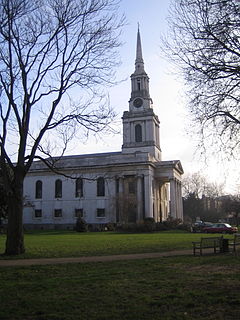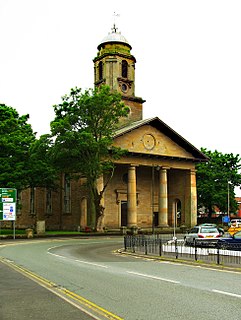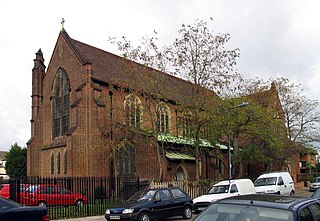
Byzantine architecture is the architecture of the Byzantine Empire, or Eastern Roman Empire.

Philip Hardwick was an English architect, particularly associated with railway stations and warehouses in London and elsewhere. Hardwick is probably best known for London's demolished Euston Arch and its twin station, the original Birmingham Curzon Street, which stands today as the oldest railway terminus building in the world.

St Clement Danes is an Anglican church in the City of Westminster, London. It is situated outside the Royal Courts of Justice on the Strand. Although the first church on the site was reputedly founded in the 9th century by the Danes, the current building was completed in 1682 by Sir Christopher Wren. Wren's building was gutted during the Blitz and not restored until 1958, when it was adapted to its current function as the central church of the Royal Air Force.

Christ Church Greyfriars, also known as Christ Church Newgate Street, was a church in Newgate Street, opposite St Paul's Cathedral in the City of London. Established as a monastic church in the thirteenth century, it became a parish church after the Dissolution of the Monasteries. Following its destruction in the Great Fire of London of 1666, it was rebuilt to the designs of Sir Christopher Wren. Except for the tower, the church was largely destroyed by bombing during the Second World War. The decision was made not to rebuild the church; the ruins are now a public garden.
Thomas Hardwick (1752–1829) was an English architect and a founding member of the Architects' Club in 1791.

All Saints Cathedral, Camden Street, London, originally All Saints Church, Camden Town, St Pancras, Middlesex, is a church in the Camden Town area of London, England. It was built for the Church of England, but it is now a Greek Orthodox church known as the Greek Orthodox Cathedral Church of All Saints. It stands where Camden Street and Pratt Street meet.

All Saints' Church, Poplar, is a church in Newby Place, Poplar, London Borough of Tower Hamlets, and is the Church of England parish church of Poplar. It was built in 1821–3 to serve the newly created parish.
There are several long-established Nordic churches in London. All seek to provide Lutheran Christian worship and pastoral care to their respective national communities in their own languages. Many of the churches also organise language classes and organise a wide range of social activities.

St Patrick's Church is a large Roman Catholic parish church in Soho Square, London. St Pat's was consecrated as a chapel in a building behind Carlisle House on 29 September 1792, one of the first Catholic buildings allowed in Great Britain after the Reformation.

St Marylebone Parish Church is an Anglican church on the Marylebone Road in London. It was built to the designs of Thomas Hardwick in 1813–17. The present site is the third used by the parish for its church. The first was further south, near Oxford Street. The church there was demolished in 1400 and a new one erected further north. This was completely rebuilt in 1740–42, and converted into a chapel-of-ease when Hardwick's church was constructed. The Marylebone area takes its name from the church. Located behind the church is St Marylebone School, a Church of England school for girls.
St. Paul's Church, George Street, was a Church of England church built as a chapel of ease to St. Mary's Church, Nottingham. It was opened in 1822 and closed in 1924.

St John's Church is in Washington Street, Workington, Cumbria, England. It is an active Anglican parish church in the deanery of Solway, the archdeaconry of West Cumberland, and the diocese of Carlisle. The church is recorded in the National Heritage List for England as a designated Grade II* listed building. It is a Commissioners' church, having received a grant towards its construction from the Church Building Commission.

Christ Church, Birmingham, was a parish church in the Church of England on Colmore Row, Birmingham from 1805 to 1899.

St Clement's Church is an active Anglican parish church in Chorlton-cum-Hardy, Manchester, England. Its daughter church, St Barnabas, serves the Barlow Moor estate and south Chorlton. St Clement's is in the Hulme deanery in the diocese of Manchester.

King Square is a square in central London, in the St Luke's area of the London Borough of Islington. It is at the corner of Lever Street and Central Street, and shares in King Square Gardens to the west.

St Barnabas Church is a Grade II listed building located in Stroud Road, Gloucester, Gloucestershire, England. It was built in 1938–40 and obtained its Grade II status on 9 March 1982. The church's denomination is the Church of England.

St Luke's Church, Ilford, is a Church of England parish church in Ilford, east London. It is dedicated to Saint Luke.

The St. Catherine of Alexandria Church is a Roman Catholic church in the Tabán quarter of Budapest, Hungary. It is the parish church of the Tabán Parish which also comprises parts of Gellért Hill and Naphegy. The church is a listed monument that was built in Central European Baroque style between 1728 and 1777. It was reconstructed several times in the 19th–20th centuries.

Christ Church, Marylebone, also called Christ Church, Lisson Grove, and Christ Church, Cosway Street, is a Grade II* listed former Church of England church, built in the 1820s in Marylebone in the City of Westminster to designs by Thomas and Philip Hardwick.

The Church of St Barnabas and St James the Greater, Walthamstow, is an Edwardian era Church of England parish church in Walthamstow, East London. It is a Grade II* listed building.


















